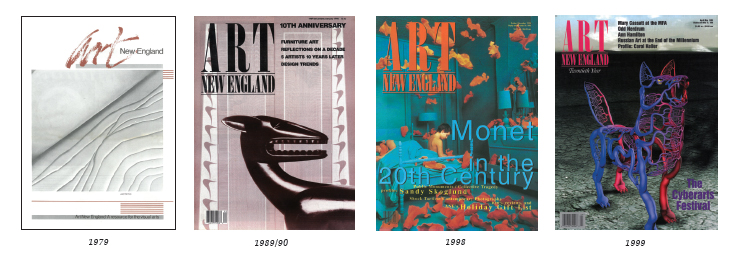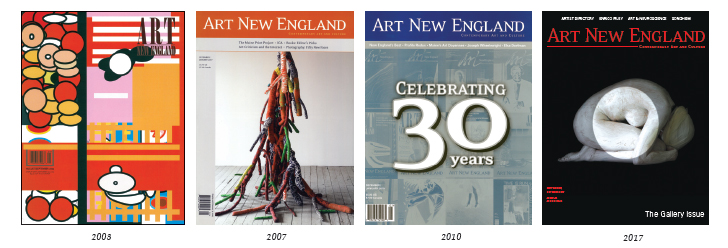Looking Back
In 1977, Carla Munsat had recently moved from Los Angeles—where she had studied painting with Richard Diebenkorn at UCLA—to the Boston area for her husband’s job when she was invited to a party at fellow artist Stephanie Adelman’s house. She walked in and saw a work by Paul Rotterdam hanging on the wall.
“You didn’t know his work,” says Adelman. “Oh, I knew his work,” says Munsat. “I might have been the only person to come into your house who loved the Paul Rotterdam,” Munsat says on a brisk fall morning when the three of us gathered over tea and cookies to discuss those early Art New England days.
Forty plus years later, Adelman and Munsat are still finishing each other’s sentences, still friends and Art New England is still going strong. In 1979, when they launched the magazine— a black-and-white newspaper—the ICA, Boston was in a transformed police headquarters at 955 Boylston Street. The Storm on the Sea of Galilee and The Concert still hung on the walls at the Isabella Stewart Gardner Museum. And Newbury Street housed the galleries— Nielsen Gallery, Harcus Krakow Gallery (now Krakow Witkin Gallery) and Gallery Naga, to name just a few. And that’s only in Boston.
Art was being made everywhere in New England, yet with the exception of Robert Taylor’s weekly column for The Boston Globe and the Boston Visual Artists Union, there weren’t too many options for artists to learn about their community or to get the word out about exhibitions. Being working artists themselves, Adelman and Munsat saw a need for such a resource and to show that New England wasn’t the art backwater many assumed.

Originally, Munsat and Adelman thought of opening a gallery to expose unrepresented artists. But when Munsat lived in Los Angeles, she had become attached to, or as she says, “obsessed with,” Cecile McCann’s Artweek, a publication that covered the West Coast art scene. She and Adelman saw a need for a similar publication in New England. Once the two agreed on the plan, they spent a year talking to area publishers. Most people “helped us once or twice,” says Munsat. There was Bernard “Bernie” Goldhirsh who founded Sail Magazine. And Stephen Mindich at The Boston Phoenix. “There was no question that we were going to do it,” says Munsat, “and it was going to work.”
“Part of the impetus of the magazine was to say there is art here,” says Adelman. “It created a sense of community. Because artists could read about themselves.”
In 1979, they launched the magazine (modeling it after Artweek), printed 4,000 copies and hand-delivered them to galleries and newsstands. Two years later, they started the Art New England Summer Workshops at Bennington College (sold to Massachusetts College of Art and Design in 2001), which continue to this day.

A photograph of Carla Munsat (left), and Stephanie Adelman (right), from an article in Sojourner, December 1980. Photo: Wendy Gross.
It was a time before computers. “I think I had the most sophisticated typewriter and I was a terrible typer, so you can imagine what it was like to put this together,” says Adelman. For the first issue, we had a woman who worked at a printing shop where they had a typesetting machine. In the evening after she worked, she would type up the copy, and she would hand us these long strips of copy. I can remember there were some nights when it was raining and we were under an umbrella and her boss did not want us to go into the shop so we’d have to wait outside.”
And then there was the now-legendary dog story. They were working on their second issue with their art director, Betty Polins, according to an article in the December/January 2010 issue of Art New England. They needed to “cut and wax typeset copy, crop and paste images and straighten columns and headlines with an X-Acto knife and a T-square.” It was their second issue and they worked throughout the night to get it to the printer by deadline the next morning since they didn’t have typesetting equipment. On their final read through, they realized they were missing a paragraph of copy. They scrambled to find it in their office which, at the time, was on the third floor of Adelman’s house. Desperate and frantic, they thought it was gone when Munsat’s golden retriever wandered into the room. The missing copy was pasted to his hair.
“I can’t believe we did it. Or how we did it.,” says Munsat. “We were so determined. We would sit there for hours: should it be Art New England For the People…By the People… By the Arts…of the Arts?”
They hired writers, many of them Harvard graduate as well as undergraduate students. There was Gary Garrels who went on to become a curator of painting and sculpture at the San Francisco Museum of Modern Art. David Bonetti who became art critic for the Boston Phoenix, The San Francisco Examiner, the San Francisco Chronicle and the St. Louis Post-Dispatch and defended Boston’s City Hall in an Art New England review. There was also David Joselit who became a distinguished professor at the graduate center of the City University of New York and the artist Lois Tarlow, who just last year won a Pollock- Krasner Foundation grant.
“Part of the impetus of the magazine was to say there is art here,” says Adelman. “It created a sense of community, because artists could read about themselves.” They published ten times a year, and after many awards and 23 years, they sold it in 2002 to Omi Rajpal and Portia Belz. Tim Montgomery, Art New England‘s current publisher, bought it in 2009.
In the last 40 years, the art scene has changed dramatically in New England. Museums have been transformed, expanded and built. Art schools have grown, merged, evolved. Public art is ubiquitous. Galleries have opened, moved and shuttered. We have seen the power of art to transform towns from North Adams, MA, to Rutland, VT. The list goes on and on. And throughout all of this, artists in New England have been going to their studios and creating.
Carla Munsat and Stephanie Adelman were right. There is art here. Great art. Worldclass artists and institutions. And you’ve been reading all about them in Art New England for 40 years.

Sarah Baker is editor in chief of Art New England.
